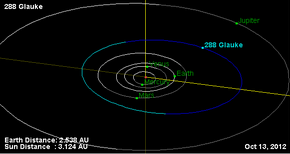|
288 Glauke
288 Glauke is a stony, tumbling asteroid and slow rotator from the intermediate asteroid belt, approximately 32 kilometers in diameter. It was discovered on 20 February 1890, by Robert Luther at Düsseldorf-Bilk Observatory in Germany. It was the last of his asteroid discoveries. It is named after Creusa (known as Glauce or Glauke), a daughter of Creon, a king of Corinth in Greek mythology.[3] Glauke has an exceptionally slow rotation period of about 1200 hours (50 days).[4] This makes it one of the slowest-rotating asteroids in the Solar System. The rotation is believed to be "tumbling", similar to the near-Earth asteroid 4179 Toutatis. It is a common, stony S-type asteroid in both the Tholen and SMASS classification.[2] References
External links
|
||||||||||||||||||||||||||||||||||||||||||||||||||||||||||||||||
